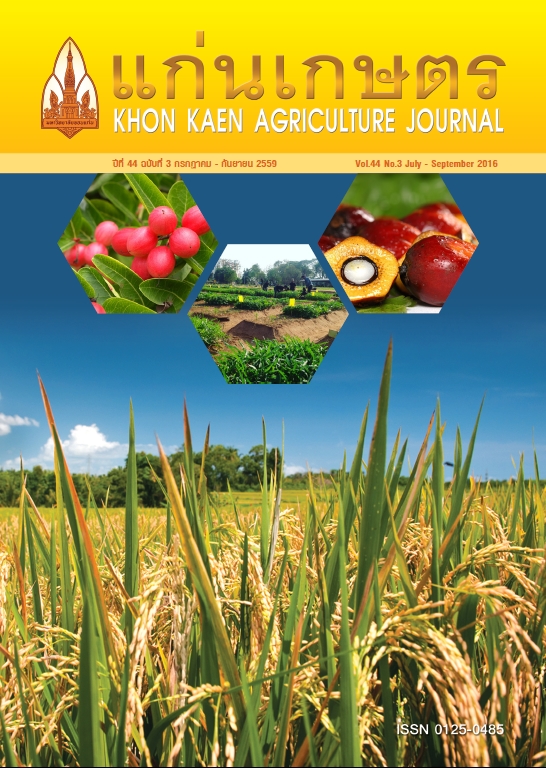A comparison of socio-economic characteristics of farmers adoption of Stone Jatropha (Vernicia montana) cultivation in northern, Lao PDR
Main Article Content
บทคัดย่อ
The objective of this study was to compare the different inherent socio-economic characteristics among Stone Jatropha (Vernicia montana) adopters in Xiengnguen district, Luangprabang province, Lao PDR. They can be classified into four groups; early adopter, majority adopter, late adopter and non-adopter. The study was carried out on 67 adopters and 89 non-adopters. The study examined the land utilization, personal factors, physical factors and economic factors. These data were collected using a structured questionnaire and descriptive statistics such as means and percentage. Results showed that land utilization for Stone Jatropha cultivation was highest in the majority adopter group (0.54 ha), while the late adopter and the early adopter utilized about 0.46 ha and 0.42 ha, respectively. Non-adopter group used the land mostly for cash crop, main crop, livestock and orchard production. As well as personal household characteristics of all adopter groups; age, gender and number of household members were higher than that of non-adopters. Approximately 34.80-50.80% of all adopters and non-adopters studied at least at primary school educational level. Husband was a key decision maker in adopters group with the percentage in this group being higher than that of non-adopters. Most of adopter and non-adopter groups were Lao Keamu and their main occupation was agriculture. The early adopters had larger land holding than did majority adopters, late adopters and non-adopters. Additionally, the adopters had higher average household income (8,213.40 $USD) than did non-adopters (3,477.70 $USD). About 83.10% of the non-adopters did not trust buyer, while half of early adopters having complete trust in the buyers.
Article Details
เอกสารอ้างอิง
Banmeke T. O. A., and M. T. Ajayi. 2008. Farmers’ Perception of the Agricultural Information Resource Centre at Ago-Are, Oyo State, Nigeria.
Brittaine R., and N. Lutaladio. 2010. Jatropha: a smallholder bioenergy crop. Food and Agriculture Organization of the United Nations, Roma. Integr. Crop Manag. 8: 96.
Burchi F. 2006. Identifying the Role of Education in Socio-Economic Development. Papers of the Annual IUE-SUNY Cortland Conference in Economics. pp. 193-206.
Ezeibe A. B., D. O. Edafiogho, N. A. Okonkwo, C. C. Okide. 2015. Gender differences and challenges in cassava production and processing in Abia State, Nigeria. African Journal of Agricultural Research. 10(22): 2259-2266.
Fisher M., and E. R. Carr. 2015. The influence of gendered roles and responsibilities on the adoption of technologies that mitigate drought risk: The case of drought-tolerant maize seed in eastern Uganda. Global Environmental Change. 35: 82-92.
Mazvimavi K., and S. Twomlow. 2009. Socioeconomic and institutional factors influencing adoption of conservation farming by vulnerable households in Zimbabwe. Agricultural Systems. 101(1-2): 20-29.
Mogaka V., A. Ehrensperger M. Iiyama, M. Birtel, E. Heim, and S. Gmuender. 2014. Understanding the underlying mechanisms of recent Jatropha curcas L. adoption by smallholders in Kenya: A rural livelihood assessment in Bondo, Kibwezi, and Kwale districts. Energy for Sustainable Development. 18: 9-15.
Mponela P., C. B. L. Jumbe, and W. F. Mwase. 2011. Determinants and extent of land allocation for Jatropha curcas L. cultivation among smallholder farmers in Malawi. Biomass and Bioenergy. 35(7): 2499-2505.
Mujeyi K. 2009. Socio-economics of commercial utilization of Jatropha (Jatropha curcas) in Mutoko district, Zimbabwe. Journal of Sustainable Development in Africa. 11(2): 36-53.
Noltze M., S. Schwarze, and M. Qaim. 2012. Understanding the adoption of system technologies in smallholder agriculture. The system of rice intensification (SRI) in Timor Leste. Agricultural Systems. 108: 64-73.
Nwakor F. N., G. E. Ifenkwe, B. C. Okoye, F. N. Onummdu, H. N. Anyaegbunam, T. O. Ekedo, and C. E. Onyia. 2011. Socio-Economic Factors Affecting Adoption of Improved Cassava Varieties among Farmers in Abia State. JASR. 11(1): 63-71.
Partala, T., and T. Saari. 2015. Understanding the most influential user experiences in successful and unsuccessful technology adoptions. Computers in Human Behavior. 53: 381-395.
Rogers, R. M. 2003. Applied mathematics in integrated navigation systems. American Institute of Aeronautics and Astronautics, Reston.Satcher, D. 1998. Tobacco Use among U. S. Racial Ethnic Minority Groups: Alaska Natives, Asian Americans and Pacific Islanders, Hispanics. DIANE Publishing.
Sysaneth, S., and L. Duangsavanh. 2009. Impacts of Jatropha Plantation on Smallholders. National Agriculture and Forestry Research Institute, TSMR Network.
Vongvisith, B., and H. Theuambounmy. 2015. Bio-Energy Science and Technology Innovation and Policy in Lao P.D.R. Journal of Sustainable Energy and Environment Special Issue. 2015: 13-18.


